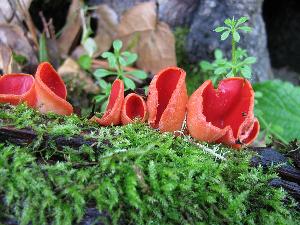
Sarcoscypha coccinea ATCC 58028 was sequenced as part of the
From Wikipedia
Sarcoscypha coccinea, commonly known as the scarlet elf cup, scarlet elf cap, or the scarlet cup, is a species of fungus in the family Sarcoscyphaceae of the order Pezizales. The fungus, widely distributed in the Northern Hemisphere, has been found in Africa, Asia, Europe, North and South America, and Australia. The type species of the genus Sarcoscypha, it has been known by many names since its first appearance in the scientific literature in 1772. Phylogenetic analysis shows the species to be most closely related to other Sarcoscypha species that contain numerous small oil droplets in their spores, such as the North Atlantic island species S. macaronesica. Due to similar physical appearances and sometimes overlapping distributions, S. coccinea has often been confused with S. occidentalis, S. austriaca, and S. dudleyi.
The saprobic fungus grows on decaying sticks and branches in damp spots on forest floors, generally buried under leaf litter or in the soil. The cup-shaped fruit bodies are usually produced during the cooler months of winter and early spring. The brilliant red interior of the cups - from which both the common and scientific names are derived - contrasts with the lighter-colored exterior. The edibility of the fruit bodies is not clearly established, but its small size, tough texture and insubstantial fruitings would dissuade most people from collecting for the table. The fungus has been used medicinally by the Oneida Indians, and also as a colorful component of table decorations in England. The species Molliardiomyces eucoccinea is an imperfect form of the fungus that lacks a sexually reproductive stage in its life cycle.
